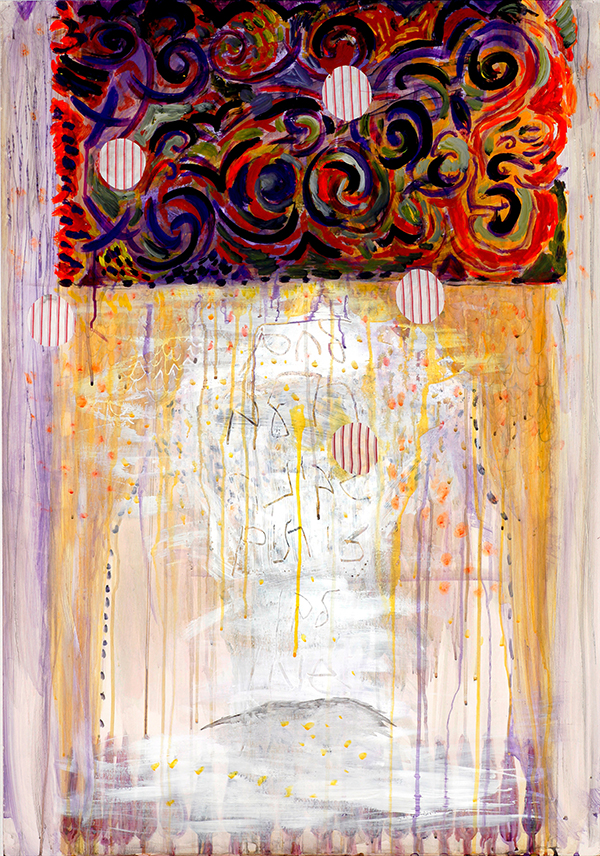דליה בכר — שני חדרים, הול ומרפסת
חמישי, 08.03.18 | שעה 20:00

אודות התערוכה
שלש סדרות של ציורים אוחזות בתערוכתה החדשה של האמנית הוותיקה דליה בכר ומסכמות שלשה פרקים מתוך הביוגרפיה המרובדת שלה. רשימת מכולת, נעימה ששון כותבת שירים, ופּיחדתי הן שלש סדרות של ציורים שנוצרו בין השנים 2007-2014 שמעולם לא הוצגו כמקשה אחת. בתערוכה זו הן כרוכות האחת באחרת ונדמה שאי אפשר להן אלא לחבור יחדיו כדי להשמיע ברצף ובאופן קולח את קולה הייחודי והטעון של בכר אודות ילדותה בבית הוריה, זהותה כילדה, אישה ואמנית, והדיסוננס בין תחושת הנוסטלגיה והרגשת אי השייכות.
חלב, לחם שחור, שמן, סוכר, אורז, ביצים וסולת הם מוצרי המזון הבסיסיים לחיים וגם מסמלים את ברכת הבית. בכתב יד ילדותי ומוגדל, על גבי מצע מואר של שכבות צבע, משתמשת בכר ברשימה הזו במרכז הסדרה רשימת מכולת, גם כדי לאזכר את משלח ידו של אביה כבעל מכולת אבל בעיקר כדי ליצור השלמה בין הקיום היומיומי המובן מאליו והבנאלי, לבין רום העולם של העשייה האמנותית, כי בלי קמח אין תורה.
הילדות, הבחירה וההשלמה, באות לידי ביטוי בסדרה פּיחדתי. חושך, חלומות ביעותים, זרים, כאב, בדידות או פרידה הם נחלת הפחד בילדות, בו מתערבבת המציאות בדמיון והגירויים מקבלים משמעות הרת גורל. בכר עוסקת בפחד הזה, שהיווה רגע מכונן בחייה של ילדה יוצאת דופן בסביבתה העמלה. כשבכר מעוותת את המילה “פחדתי”, היא מפחיתה מאימת הילדה שהייתה, ומעניקה לה חיזוק אמנותי מצד אחד, ומצד שני מבקשת את אהדת הצופה הבוגר שיכיל את פחדיה.
נעימה ששון כותבת שירים הוא שם סיפור קצר מאת עמליה כהנא כרמון, אודות המתבגרת נעימה המתאהבת במורה שלה יחזקאל, אבל זהו גם סיפור על נערה שרוצה להיות סופרת. בהחלטה זו יש אלמנט מרדני או לפחות ניסיון לחרוג מגבולות הקונבנציה והיומיום. נעימה יודעת שיש פער בין היש הגלוי לבין מה שגלום מעבר לו, והיא גם יודעת שאת הפער הזה תצטרך לבטא בכתיבתה כסופרת. הסדרה הזו, החותמת את פרק הילדות של בכר, היא משל וחזרה על בחירתה באמנות כמקור, כביטוי וככלי לחיים. כפי שנעימה החליטה על ייעודה כסופרת כך התוודעה בכר לייעודה כאמנית.
כל העבודות על נייר בגודל אחיד 70X100 ס”מ, מהוות מעין חלונות לנפשה של האמנית. לאון בטיסטה אלברטי, צייר ואדריכל בן המאה ה- 15, תאר כיצד הוא ניגש לצייר את המציאות הנגלית לנגד עיניו: “אני מצייר מרובע בעל זוויות ישרות בגודל הרצוי לי, מתאר לי אותו כאילו הוא חלון פתוח שמבעדו אני מסתכל במה שעומד אני לצייר עליו”.
בעיני אלברטי, מסגרת הציור היא חלון לנוף ולמציאות. בכר משתמשת במסגרת הציור כראי לנפש, על מנת לספר את רזי רוחה המרדנית והנועזת מצד אחד, הלירית והענוגה מן הצד האחר. התוצאה היא ציורי תודעה רהוטים ומרהיבים.
נעילת התערוכה: 08.04.18
Dalia Bachar — Two Rooms, A Corridor And A Terrace
Thursday 08.03.18 | at 20:00
Three series of paintings constitute veteran artist Dalia Bachar’s new exhibition, summarizing three chapters from her multi-faceted biography. \A grocery list, Neima Sasson Writes Poems, and I Was Escared, are three series of paintings created between the years 2007-2014, never exhibited as a single entity. In this exhibition they are intertwined and assemble to sound eloquently and fluently Bachar’s unique charged voice on her childhood in her parents’ house, her identity as a child, woman and artist, and the dissonance between her feelings of nostalgia and sentiment of not belonging.
Milk, black bread, oil, sugar, rice, eggs and semolina are fundamental foodstuffs for life and at the same time represent the house blessing. In oversized childish handwriting over a lit substrate of paint layers, Bachar uses this list at the center of the Grocery List series, to also reference her father’s trade as a grocery owner but mainly to establish a synthesis between the quotidian, banal existence taken for granted and the apex of artistic creativity, because “No flour, no Tora”.
Childhood, choices and acceptance are represented in the series I was escared. Darkness, nightmares, strangers, pain, loneliness and separation are the territory of fear in a childhood where reality is intertwined with imagination and stimuli, to establish existential significance. Bachar is preoccupied with this fear which constituted a defining moment in the life of a girl, exceptional in her laboring environment. When Bachar twists the word “scared” she downplays the fright of the girl she was, artistically intensifying her on one hand while on the other she appeals at the adult viewer’s sympathy to contain her fears.
Neima Sasson Writes Poems is the name of a short story by Amalya Kahana-Carmon about Neima, an adolescent girl falling in love with Ezekiel – her teacher, but it’s also a story about a girl aspiring to become a writer. This resolution contains a rebellious element or at least an attempt to emerge from the boundaries of daily convention. Neima knows that there is a chasm between the evident reality and what is contained beyond it. She also knows that she will have to articulate this chasm in her work as a writer. This series sealing Bachar’s childhood chapter is an allegory and replication of her choice of art as a source, an expression, a vessel of life. Just as Neima was determined on her calling as a writer, so was Bachar exposed to her vocation as an artist.
All the works on paper in uniform size of 70X100 cm form windows into the artist’s soul. Leon Battista Alberti, 15th century painter and architect, described how he approached painting the reality facing him: “First of all, on the surface which I am going to paint, I draw a rectangle of whatever size I want, which I regard as an open window through which the subject to be painted is seen.” For Alberti the picture’s frame is a window to the scenery, to reality. Bachar uses the painting’s frame as a mirror to the soul telling the secrets of its bold, rebellious spirit on one hand, lyric and delicate on the other. The outcome is conscience paintings, eloquent and spectacular.
Closing: 08.04.18
